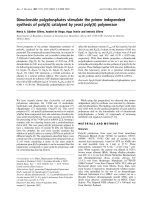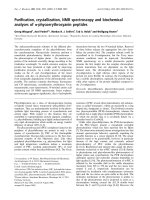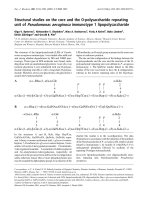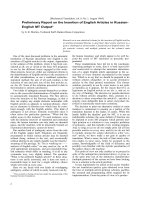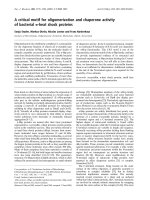Báo cáo y học: " Preliminary data concerning the reliability and psychometric properties of the Greek translation of the 20-item Subjective Well-Being Under Neuroleptic Treatment Scale (SWN-20)" pdf
Bạn đang xem bản rút gọn của tài liệu. Xem và tải ngay bản đầy đủ của tài liệu tại đây (239.33 KB, 8 trang )
BioMed Central
Page 1 of 8
(page number not for citation purposes)
Annals of General Psychiatry
Open Access
Primary research
Preliminary data concerning the reliability and psychometric
properties of the Greek translation of the 20-item Subjective
Well-Being Under Neuroleptic Treatment Scale (SWN-20)
Melina Siamouli
1
, Katerina Moutou
1
, Eleonora Pantoula
1
,
Stamatia Magiria*
2
, Irini Chatzivasileiou
3
, Konstantinos Arapidis
4
,
Achileas Chatzivasileiou
5
, Simeon Deres
1
and Konstantinos N Fountoulakis
6
Address:
1
Asclepius Mental Clinic, Veroia, Greece,
2
School of Medicine, Aristotle University of Thessaloniki, Greece,
3
State Mental Hospital of
Thessaloniki, Greece,
4
Therapeutirio Spinari Mental Clinic, Kozani, Greece,
5
Agios Georgios Mental Clinic, Panorama Thessaloniki, Greece and
6
Third Department of Psychiatry, School of Medicine, Aristotle University of Thessaloniki, Greece
Email: Melina Siamouli - ; Katerina Moutou - ; Eleonora Pantoula - ;
Stamatia Magiria* - ; Irini Chatzivasileiou - ; Konstantinos Arapidis - ;
Achileas Chatzivasileiou - ; Simeon Deres - ; Konstantinos N Fountoulakis -
* Corresponding author
Abstract
Background: The 20-item Subjective Well-Being Under Neuroleptic Treatment Scale (SWN-20)
is a self-report scale developed in order to assess the well-being of patients receiving antipsychotic
medication independent of the improvement in their psychotic symptoms. The current study
reports on the reliability and the psychometric properties of the Greek translation of the SWN-20.
Methods: A total of 100 inpatients or outpatients with schizophrenia (79 males and 21 females,
aged 42.6 ± 11.35 years old) from 3 different facilities were assessed with the Positive and Negative
Symptoms Scale (PANSS), the Calgary Depression Scale and the Simpson-Angus Scale, and
completed the SWN-20. The statistical analysis included the calculation of Pearson product
moment correlation coefficient, the Cronbach α and factor analysis with Varimax normalised
rotation.
Results: The SWN-20 had an α value equal to 0.79 and all the items were equal. The factor analysis
revealed the presence of seven factors explaining 66% of total variance. The correlation matrix
revealed a moderate relationship of the SWN-20 and its factors with the PANSS-Negative (PANSS-
N), PANSS-General Psychopathology (PANSS-G), the Simpson-Angus and the Calgary scales, and
no relationship to age, education and income class.
Discussion: The Greek translation of the SWN-20 is reliable, with psychometric properties close
to the original scale.
Published: 21 January 2009
Annals of General Psychiatry 2009, 8:3 doi:10.1186/1744-859X-8-3
Received: 5 November 2008
Accepted: 21 January 2009
This article is available from: />© 2009 Siamouli et al; licensee BioMed Central Ltd.
This is an Open Access article distributed under the terms of the Creative Commons Attribution License ( />),
which permits unrestricted use, distribution, and reproduction in any medium, provided the original work is properly cited.
Annals of General Psychiatry 2009, 8:3 />Page 2 of 8
(page number not for citation purposes)
Background
In the past, the standard approach to the assessment of
antipsychotic treatment was the rating of symptoms. In
this frame, the patients' perspective concerning pharma-
cological treatment was largely neglected. However during
the last couple of decades, especially after the develop-
ment of second-generation antipsychotics (SGAs),
research interest on this issue has markedly increased.
Moreover, the interest concerning the quality of life of
mental patients and their subjective sense of well-being,
particularly of patients with schizophrenia has also
increased. This increase is, at least partially, attributed to a
supposed favourable effect of SGAs [1].
Quality of life (QoL) and subjective well-being (SWB) are
different concepts with SWB being part of overall QoL.
They both constitute a conceptual extension of therapeu-
tic outcome criteria [2]. The patient satisfaction seems to
correlate strongly to the patient's willingness to be or stay
under any kind of treatment, thus determining the overall
outcome to a significant extent [3]. In this context, the
goals of treatment in schizophrenia nowadays include
patient-related factors such as subjective response and
quality of life. The patient's satisfaction with antipsychotic
therapy is influenced by a number of different and maybe
loosely related factors. These factors include medication
adverse effects, psychoeducation, lack of involvement in
decision making (concerning both the patient and his/her
family) and the existence or absence of a therapeutic alli-
ance [4,5]. However, the patient's perceptions concerning
their treatment are not strongly related to the severity of
illness or symptoms; on the contrary, there seems to be an
association between perceptions of treatment and medi-
cation adverse effects. In essence, this means that the
patient's perspectives markedly differ from these of his/
her psychiatrist [6]. If this is the case, then a relative lack
of adverse effects with newer drugs could result in higher
levels of satisfaction and subjective well-being, but this
remains to be proven [3,6,7]. The existence of both exter-
nal and inner motivations underpinning the patients' atti-
tudes towards medication and treatment in general
suggests that any intervention needs to take into account
both the disease and the person it afflicts, including his
subjective experience, in a personalised way of treatment
[8].
Methodologically, QoL and SWB are assessed with the use
of rating scales, some of them being self-report ones.
Although there are significant problems with definitions
and with the reliability and validity of these scales, they
constitute valuable tools for the assessment of the overall
course of patients. Several studies have shown that the
majority of schizophrenic patients are able to complete a
self-rating scale in a reliable way [6].
The 20-item Subjective Well-Being Under Neuroleptic
Treatment Scale (SWN-20) [9,10] is a self-report scale
developed in order to assess the well-being of patients
receiving antipsychotic medication, regardless of the
improvement in their psychotic symptoms. The current
study reports on the reliability and the psychometric
properties of the Greek translation of the SWN-20.
Methods
Study sample
The study sample included 100 in or outpatients suffering
from schizophrenia (21 females (21%) and 79 males
(79%)) aged 42.6 ± 11.35 (range 19 to 65 years old). Par-
ticipants came from three different private care facilities.
All patients gave informed consent and the protocol
received approval by the Aristotle University of Thessalo-
niki's Ethics Committee.
Clinical diagnosis
Diagnosis was made according to Diagnostic and Statisti-
cal Manual of Mental Disorders version IV Text Revision
(DSM-IV-TR) criteria on the basis of a semi-structured
interview. Patients were physically healthy with normal
clinical and laboratory findings.
Translation and back translation
Translation and back translation were made by two of the
authors; one of whom did the translation and the other
who did not know the original English text did the back
translation. The final translation was finalised by consen-
sus between them. The translated scale is shown in Figure
1.
Psychometric assessment
All patients were assessed with the Positive and Negative
Symptoms Scale (PANSS) (for the overall assessment of
the severity of psychotic symptoms), the Calgary Depres-
sion Scale (for the assessment of depression), the Simp-
son-Angus Scale (for the assessment of side effects) and
completed the SWN-20.
Statistical analysis
Descriptive statistics for all scales were calculated. Item
analysis [11] was performed, and the value of the Cron-
bach α for the SWN-20 was calculated. Principal compo-
nent analysis (without and after Varimax normalised
rotation) [12] was performed, and factor coefficients and
scores were calculated. The Pearson correlation coefficient
(R) was calculated to assess the relationship of the SWN-
20 and its factors to the other psychometric tests.
Results
The means and standard deviations for the scores for all
scales are shown in Table 1. The SWN-20 had a Cronbach
Annals of General Psychiatry 2009, 8:3 />Page 3 of 8
(page number not for citation purposes)
Subjective Well-being Under Neuroleptic Treatment Scale (SWN) in GreekFigure 1
Subjective Well-being Under Neuroleptic Treatment Scale (SWN) in Greek.
ȊʌȠțİȚμİȞȚțȒ ǼȣİȟȓĮ ȣʌȩ ĮȖȦȖȒ μİ ȃİȣȡȠȜȘʌIJȚțȐ
D. Naber
ǼȜȜȘȞȚțȒ ȂİIJȐijȡĮıȘ-ıIJȐșμȚıȘ: ȈȚĮμȠȪȜȘ țĮȚ ıȣȞ, 2008
ȆĮȡĮțĮȜȫ ʌȡȠıȑȟIJİ: ǵȜİȢ ȠȚ ʌȡȠIJȐıİȚȢ ĮȞĮijȑȡȠȞIJĮȚ ıIJȚȢ 7 ʌȡȠȘȖȠȪμİȞİȢ ȘμȑȡİȢ. ȆĮȡĮțĮȜȫ ıȘμİȚȫıIJİ IJȘȞ
țĮIJȐȜȜȘȜȘ ĮʌȐȞIJȘıȘ.
ȀĮșȩȜȠȣ
ȆȠȜȪ ȜȓȖȠ
ȁȓȖȠ
ǹȡțİIJȐ
ȆȠȜȪ
ȆȐȡĮ ʌȠȜȪ
1. ȃȚȫșȦ ĮȞȓıȤȣȡȠȢ țĮȚ įİȞ ȑȤȦ ȑȜİȖȤȠ IJȠȣ İĮȣIJȠȪ μȠȣ.
{{{{{{
2. ȃȚȫșȦ ʌȠȜȪ ȐȞİIJĮ μİIJȠıȫμĮ μȠȣ.
{{{{{{
3. ȂȠȣ ijĮȓȞİIJĮȚ İȪțȠȜȠ IJȠ ȞĮ ıțȑijIJȠμĮȚ.
{{{{{{
4. ǻİȞ ȑȤȦ țĮμȓĮ İȜʌȓįĮ ȖȚĮ IJȠ μȑȜȜȠȞ.
{{{{{{
5. ȃȚȫșȦ IJȠ ıȫμĮ μȠȣ ȠȚțİȓȠ.
{{{{{{
6. ǼȓμĮȚ ȞIJȡȠʌĮȜȩȢ ȩIJĮȞ ȖȞȦȡȓȗȦ țĮȚȞȠȪȡȖȚȠȣȢ ĮȞșȡȫʌȠȣȢ.
{{{{{{
7. ǼȓμĮȚ ȖİμȐIJȠȢ ȚįȑİȢ țĮȚ ijĮȞIJĮıȓĮ.
{{{{{{
8. ȉȠ ʌİȡȚȕȐȜȜȠȞ μȠȣ, μȠȣ ijĮȓȞİIJĮȚ ijȚȜȚțȩ țĮȚ ȠȚțİȓȠ.
{{{{{{
9. ȃȚȫșȦ ĮįȪȞĮμȠȢ țĮȚ İȟĮıșİȞȘμȑȞȠȢ.
{{{{{{
10. ȉĮ ıȣȞĮȚıșȒμĮIJĮ țĮȚ ȠȚ ĮȚıșȒıİȚȢ μȠȣ İȓȞĮȚ İʌȓʌİįĮ. ȉȓʌȠIJĮ įİȞ
ȑȤİȚ ıȘμĮıȓĮ ȖȚĮ μȑȞĮ.
{{{{{{
11. ȈțȑijIJȠμĮȚ ĮȡȖȐ țĮȚ μİ įȣıțȠȜȓĮ.
{{{{{{
12. ȉĮ ıȣȞĮȚıșȒμĮIJĮ țĮȚ Ș ıȣμʌİȡȚijȠȡȐ μȠȣ įİȞ ĮȡμȩȗȠȣȞ ıIJȚȢ
ʌİȡȚıIJȐıİȚȢ. ȈIJİȞȠȤȦȡȚȑμĮȚ ȖȚĮ μȚțȡȐ ʌȡȐȖμĮIJĮ İȞȫ IJĮ ıȘμĮȞIJȚțȐ
μİ İʌȘȡİȐȗȠȣȞ İȜȐȤȚıIJĮ.
{{{{{{
13. ȂȠȣ İȓȞĮȚ İȪțȠȜȠ ȞĮ įȚĮIJȘȡȫ İʌĮijȒ μİ IJȠȣȢ ĮȞșȡȫʌȠȣȢ ȖȪȡȦ μȠȣ.
{{{{{{
14. ǹȞIJȚȜĮμȕȐȞȠμĮȚ IJȠ ʌİȡȚȕȐȜȜȠȞ μȠȣ ȦȢ ĮȜȜĮȖμȑȞȠ, ʌİȡȓİȡȖȠ țĮȚ
ĮʌİȚȜȘIJȚțȩ.
{{{{{{
15. ȂʌȠȡȫ ȞĮ įȚĮȤȦȡȓıȦ IJȠȞ İĮȣIJȩ μȠȣ Įʌȩ IJȠȣȢ ȐȜȜȠȣȢ ĮȞșȡȫʌȠȣȢ.
{{{{{{
16. ȉȠ ıȫμĮ μȠȣ, μȠȣ İȓȞĮȚ ȕȐȡȠȢ.
{{{{{{
17. ȅȚ ıțȑȥİȚȢ μȠȣ ʌİIJȠȪȞ țĮȚ įİȞ țĮIJİȣșȪȞȠȞIJĮȚ. ǻȣıțȠȜİȪȠμĮȚ ȞĮ
ıțİijIJȫ țĮșĮȡȐ.
{{{{{{
18. ȅıĮ ıȣμȕĮȓȞȠȣȞ ȖȪȡȦ μȠȣ μİ İȞįȚĮijȑȡȠȣȞ țĮȚ IJĮ ȕȡȓıțȦ
ıȘμĮȞIJȚțȐ.
{{{{{{
19. ȉĮ ıȣȞĮȚıșȒμĮIJĮ țĮȚ Ș ıȣμʌİȡȚijȠȡȐ μȠȣ İȓȞĮȚ IJĮ țĮIJȐȜȜȘȜĮ ȖȚĮ
IJȘȞ țȐșİ ʌİȡȓıIJĮıȘ.
{{{{{{
20. ǼȓμĮȚ ȖİμȐIJȠȢ ıȚȖȠȣȡȚȐ ȩIJȚ ȩȜĮ șĮ ʌȐȞİ țĮȜȐ.
{{{{{{
Annals of General Psychiatry 2009, 8:3 />Page 4 of 8
(page number not for citation purposes)
α equal to 0.79 and all the items were equal. The factor
analysis (Table 2) revealed the presence of seven factors
explaining 66% of total variance.
Some items load equally to more than one factor. Item 9
equally loads to factors 1, 2, 6 and 9. Item 11 loads to fac-
tors 1 and 6, item 13 to factors 4, 6 and 7 and item 17 to
factors 2, 4 and 6.
Factor 1 includes items 1, 7, 9 and 11 and largely reflects
'mental control'. Factor 2 includes items 2, 3, 9, 16 and 17
and largely reflects a 'combined mental-physical control'.
Factor 3 includes items 4, 10 and 12 and largely reflects
'depression and loss of emotional control'. Factor 4
includes items 13, 17, 18 and 20 and reflects 'optimism'.
Factor 5 includes items 5, 15 and 19 and reflects 'self-
awareness. Factor 6 includes items 6, 9, 11, 13, and 17 and
reflects 'lack of self confidence'. Finally factor 7 includes
items 8, 9, 13 and 14 and possibly reflects a 'cognitive def-
icit' especially concerning the interpersonal domain.
The correlation matrix (Table 3) revealed a moderate-
weak relationship of the SWN-20 and its factors with the
PANSS-Positive (PANSS-P), PANSS-Negative (PANSS-N),
PANSS-General Psychopathology (PANSS-G), the Simp-
son-Angus and the Calgary scales, and no relationship to
age, education and income class.
Discussion
The Greek version of the SWN-20 is reliable with psycho-
metric properties close to the original scale. A study simi-
lar to ours that evaluated the psychometric properties of
the Italian version of the SWN showed a good perform-
ance as documented by the internal consistency, with a
Cronbach α equal to 0.85 [13], very close to that of the
Greek version (0.79). The study also reported a satisfac-
tory subjective experience in the sample's patients (SWN
mean total score 84.95, standard deviation (SD): 17.5)
[13], whereas our findings are fairly different (SWN mean
total score 66.73, SD: 14.33), probably due to the fact that
our sample consisted mainly of chronic schizophrenic
patients.
A German study applied structural equation modelling
(SEM) to the data from 360 patients with schizophrenia
in order to produce 5-item and 10-item indexes based
on the SWN scale. The 5-item index produced seems to
be a valid, time-saving tool for the assessment of the
patients' perception of well-being, and thus quality of
life [9].
Table 1: Descriptive statistics of scales scores
Scale Mean Minimum Maximum SD
SWN-20 66.73 21 95 14.33
PANSS-Positive subscale 15.12 8 32 4.76
PANSS-Negative subscale 17.82 9 37 5.13
PANSS-General Psychopathology subscale 27.21 17 45 6.04
Calgary Depression Scale 1.27 0 11 2.20
Simpson-Angus Scale 1.59 0 8 2.14
SWN-20 factor 1 12.53 3 20 3.65
SWN-20 factor 2 16.22 2 25 5.29
SWN-20 factor 3 8.01 0 10 2.53
SWN-20 factor 4 13.34 1 20 4.16
SWN-20 factor 5 9.62 0 15 3.19
SWN-20 factor 6 16.71 1 25 5.31
SWN-20 factor 7 12.80 2 20 4.49
PANSS:Positive and Negative Symptoms Scale; SD: standard deviation; SWN-20:, Subjective Well-being under Neuroleptic Treatment scale.
Annals of General Psychiatry 2009, 8:3 />Page 5 of 8
(page number not for citation purposes)
Using the Quality of Life Scale (QLS) and SWN-20 scales,
a prospective naturalistic study assessed the QoL and SWB
of outpatients with schizophrenia on antipsychotic medi-
cation over a 12-month period. The analysis revealed the
presence of four different patient groups: a group with
continuously high QoL (23.2%), a group with continu-
ously moderate QoL (48.5%), a group with low QoL
(11.2%) and a group with improving QoL (19.9%) [14].
Patients and psychiatrists seem to perceive treatment and
medication side effects in a very different way. A ran-
domised double-blind multicentre trial evaluated the
Table 2: Results of the factor analysis of SWN-20
Factor 1 Factor 2 Factor 3 Factor 4 Factor 5 Factor 6 Factor 7
SWN-1 0.60 0.30 0.12 0.25 -0.10 -0.05 0.18
SWN-2 0.02 0.56 -0.02 0.40 0.12 -0.02 0.19
SWN-3 -0.36 0.52 0.10 0.37 0.04 0.23 -0.22
SWN-4 -0.06 0.12 0.76 0.15 -0.02 -0.31 -0.09
SWN-5 0.00 0.27 0.36 0.22 0.60 0.06 0.12
SWN-6 -0.12 0.04 -0.02 -0.07 0.02 0.77 0.05
SWN-7 -0.79 0.16 -0.08 0.16 -0.02 -0.01 -0.01
SWN-8 0.09 -0.03 0.04 0.31 0.28 0.01 0.70
SWN-9 0.30 0.44 0.03 -0.07 -0.18 0.36 0.39
SWN-10 0.05 0.14 0.70 0.13 0.04 0.19 0.34
SWN-11 0.44 0.42 0.02 0.16 0.23 0.56 -0.06
SWN-12 0.22 -0.01 0.80 -0.12 0.14 0.15 0.02
SWN-13 -0.21 -0.16 0.28 0.55 0.12 0.41 0.37
SWN-14 0.06 0.30 0.11 -0.06 -0.05 0.10 0.76
SWN-15 -0.14 0.06 0.09 0.02 0.75 0.12 -0.14
SWN-16 -0.02 0.73 0.22 -0.13 0.28 0.10 0.19
SWN-17 0.19 0.45 0.12 0.31 0.02 0.54 0.13
SWN-18 0.01 0.04 -0.07 0.81 0.16 0.10 -0.06
SWN-19 0.14 0.06 -0.11 0.15 0.76 -0.10 0.32
SWN-20 0.02 0.22 0.22 0.62 0.04 -0.26 0.25
Proportion of total 8% 10% 10% 11% 9% 9% 9%
Total explained 66%
Values in bold underlined are factor loadings determining to which factor the specific item belongs to. SWN, Subjective Well-Being Under
Neuroleptic Treatment Scale.
Annals of General Psychiatry 2009, 8:3 />Page 6 of 8
(page number not for citation purposes)
effects of olanzapine and clozapine on subjective well-
being and clinical outcome after 26 weeks of treatment in
114 patients with schizophrenia. The results revealed only
a moderate correlation between SWN and PANSS scores,
indicating the difference of perception between patients
and psychiatrists [15]. Our results are in accordance with
these findings, showing a moderate to weak correlation
between SWN and PANSS scores.
The majority of patients with schizophrenia seem to be
satisfied with their life in general, although certain areas
are most commonly described as dissatisfactory. Hofer et
al. indicated partnership and mental health as the most
commonly noted areas. They also concluded that SWB
was negatively influenced by the depression/anxiety com-
ponent of the PANSS, extrapyramidal symptoms and a
negative attitude towards antipsychotics [16]. Side effects
of antipsychotic medication are generally considered as a
major source of subjective discomfort among patients,
leading to poor SWB [17]. A study of 161 patients suffer-
ing from schizophrenia found that patients with side
effects were less satisfied with life domains of subjective
feelings and general activities than asymptomatic
patients, and that QoL seems to be influenced by the
patient's subjective response to side effects [18]. Patients
receiving SGAs report a high perceived quality of life in
various aspects of life, although metabolic disturbances
seem to have a significant detrimental effect [19]. How-
ever, schizophrenic patients that, where switched from an
SGA to a first-generation antipsychotic (FGA) for clinical
reasons, reported no disadvantage concerning symptoms
and quality of life over a 1-year period [20]. Moreover, a
study of 1,462 patients with schizophrenia, treated either
with FGAs or SGAs showed that both quality of life and
symptom severity improved over the study period, regard-
less of the antipsychotic taken, indicating that the type of
antipsychotic does not seem to have an effect on satisfac-
tion with life [21]. Tempier et al. found that patients
receiving SGAs had lower scores in certain items about
social relationships than patients receiving FGAs, which
may be at least partially attributed to the fact that patients
receiving SGAs have greater expectations from life [22].
Research data also suggest that SWB is a major determi-
nant of adherence to treatment. In a multicentre observa-
tional study of 2960 patients suffering from
schizophrenia, SWB was assessed over a 12-month period,
with the use of SWN-20. The results showed that that the
odds for being compliant were 1.363 times higher if the
SWN-20 score increased by 20 points, indicating a strong
association between SWB and adherence to treatment
[23]. Although most of the studies are inconclusive and
their results inconsistent, SGAs seem to be superior to
FGAs in ameliorating subjective tolerability and quality of
life, thus improving adherence to treatment [24]. How-
ever, a study of 106 schizophrenic and bipolar patients
that investigated the correlation between SWB and adher-
ence to treatment, showed that although patients receiv-
ing SGAs reported a better subjective response than those
receiving FGAs, adherence to treatment did not differ
between the two groups [25]. In any case, the assessment
of the patient's subjective experience may be of use in the
evaluation of the differential effects of antipsychotics and
their dose in SWB and thus adherence to treatment [26].
Table 3: Correlation among the SWN-20 total score and factor subscales with the rest of psychometric scales and demographic
variables
SWN Factor 1 Factor 2 Factor 3 Factor 4 Factor 5 Factor 6 Factor 7
Age 0.03 0.06 0.14 0.08 -0.01 -0.07 0.15 0.06
Education 0.07 -0.11 -0.08 -0.04 0.17 0.19 -0.13 -0.02
Income -0.09 -0.03 -0.12 0.04 -0.04 -0.11 -0.01 -0.03
PANSS-Positive subscale -0.19 -0.28 -0.17 -0.11 -0.14 -0.03 -0.28 -0.33
PANSS-Negative subscale -0.35 -0.18 -0.26 -0.16 -0.33 -0.30 -0.29 -0.15
PANSS-General Psychopathology subscale -0.36 -0.29 -0.39 -0.24 -0.28 -0.09 -0.37 -0.31
Calgary Depression Scale -0.44 -0.27 -0.37 -0.47 -0.35 -0.07 -0.24 -0.35
Simpson-Angus Scale -0.22 -0.26 -0.23 0.06 -0.12 -0.18 -0.24 -0.18
Values in bold are statistically significant at p < 0.05.
PANSS, Positive and Negative Symptoms Scale; SWN-20, 20-item Subjective Well-Being Under Neuroleptic Treatment Scale.
Annals of General Psychiatry 2009, 8:3 />Page 7 of 8
(page number not for citation purposes)
Subjective well-being may also be an index of sympto-
matic remission over time and thus of predictive validity
for the course of the disease. A prospective study of 110
patients suffering from first episode schizophrenia or
related disorders investigated the impact of early improve-
ment of subjective experience and early improvement of
rater-assessed symptoms on symptomatic remission over
a 5-year period. Patients with enduring symptomatic
remission had a higher mean improvement of SWB dur-
ing early treatment, as assessed with the SWN-20, than
those without enduring symptomatic remission, indicat-
ing an association between SWB and long-term remission
[27].
In conclusion, subjective well-being is a very important,
yet neglected, concept concerning the treatment of
patients with schizophrenia receiving antipsychotics. The
subjective effects of antipsychotic medication seem to sig-
nificantly affect the patients' quality of life and willingness
to stay under treatment, thus should be considered more
thoroughly, both in clinical research and clinical practice.
The SWN-20 is a simple, easy to use, self-report scale for
the reliable assessment of the well-being of patients under
treatment with neuroleptics. The Greek translation of the
SWN-20 is reliable with psychometric properties close to
the original scale, and can be of use in implementing the
treatment of patients with schizophrenia.
Competing interests
KNF is member of the International Consultation Board
of Wyeth for desvenlafaxine and has received honoraria
for lectures from AstraZeneca, Janssen-Cilag, Eli-Lilly and
research grants from AstraZeneca and Pfizer Foundation
MS, SM, KA, AC and SD received support to participate in
congresses by the following companies: AstraZeneca, Bris-
tol-Myers-Squibb, Eli-Lilly, Janssen-Cilag, Lundbeck,
Novartis, Organon, Pfizer, Sanofi.
Authors' contributions
KNF designed the study and participated in the analysis of
the data, interpretation and writing of the manuscript MS,
KM, EP, SM, IC, KA, AC and SD participated in the gather-
ing of the data, interpretation of the results and writing of
the manuscript.
Acknowledgements
The study was based on a research grant by AstraZenca Greece.
References
1. Bobes J, Garcia-Portilla MP, Bascaran MT, Saiz PA, Bousono M: Qual-
ity of life in schizophrenic patients. Dialogues Clin Neurosci 2007,
9(2):215-226.
2. Lambert M, Naber D: Current issues in schizophrenia: over-
view of patient acceptability, functioning capacity and qual-
ity of life. CNS Drugs 2004, 18(Suppl 2):5-17.
3. Hellewell JS: Patients' subjective experiences of antipsychot-
ics: clinical relevance. CNS Drugs 2002, 16(7):457-471.
4. Awad AG, Voruganti LN, Heslegrave RJ, Hogan TP: Assessment of
the patient's subjective experience in acute neuroleptic
treatment: implications for compliance and outcome. Int Clin
Psychopharmacol 1996, 11(Suppl 2):55-59.
5. Chue P: The relationship between patient satisfaction and
treatment outcomes in schizophrenia. J Psychopharmacol 2006,
20(6 Suppl):38-56.
6. de Millas W, Lambert M, Naber D: The impact of subjective well-
being under neuroleptic treatment on compliance and
remission. Dialogues Clin Neurosci 2006, 8(1):131-136.
7. Awad AG, Voruganti LN: Quality of life and new antipsychotics
in schizophrenia. Are patients better off? Int J Soc Psychiatry
1999, 45(4):268-275.
8. Santone G, Rucci P, Muratori ML, Monaci A, Ciarafoni C, Borsetti G:
Attitudes toward medication in inpatients with schizophre-
nia: a cluster analytic approach. Psychiatry Res 2008,
158(3):324-334.
9. Schmidt P, Clouth J, Haggenmuller L, Naber D, Reitberger U: Con-
structing an Index for the Subjective Well-being Under Neu-
roleptics scale (SWN), short form: applying structural
equation modeling for testing reliability and validity of the
index. Qual Life Res 2006, 15(7):1191-1202.
10. Naber D: A self-rating to measure subjective effects of neu-
roleptic drugs, relationships to objective psychopathology,
quality of life, compliance and other clinical variables. Int Clin
Psychopharmacol 1995, 10(Suppl 3):133-138.
11. Anastasi A: Psychological Testing. 6th edition. New York: Mac-
millan Publishing Company; 1988.
12. Altman D: Practical Statistics for Medical Research. London:
Chapman and Hall; 1991.
13. Balestrieri M, Giaroli G, Mazzi M, Bellantuono C: Performance of
the Italian version of the subjective well-being under neu-
roleptic (SWN) scale in schizophrenic outpatients. Pharma-
copsychiatry 2006, 39(3):81-84.
14. Wehmeier PM, Kluge M, Schacht A, Helsberg K, Schreiber W, Schim-
melmann BG, Lambert M: Patterns of physician and patient
rated quality of life during antipsychotic treatment in outpa-
tients with schizophrenia. J Psychiatr Res 2008, 42(8):676-683.
15. Naber D, Riedel M, Klimke A, Vorbach EU, Lambert M, Kuhn KU,
Bender S, Bandelow B, Lemmer W, Moritz S, et al.: Randomized
double blind comparison of olanzapine vs. clozapine on sub-
jective well-being and clinical outcome in patients with schiz-
ophrenia. Acta Psychiatr Scand 2005, 111(2):106-115.
16. Hofer A, Kemmler G, Eder U, Edlinger M, Hummer M, Fleischhacker
WW: Quality of life in schizophrenia: the impact of psycho-
pathology, attitude toward medication, and side effects. J Clin
Psychiatry 2004, 65(7):932-939.
17. Schimmelmann BG, Paulus S, Schacht M, Tilgner C, Schulte-Markwort
M, Lambert M: Subjective distress related to side effects and
subjective well-being in first admitted adolescents with
early-onset psychosis treated with atypical antipsychotics. J
Child Adolesc Psychopharmacol 2005, 15(2):249-258.
18. Ritsner M, Ponizovsky A, Endicott J, Nechamkin Y, Rauchverger B, Sil-
ver H, Modai I: The impact of side-effects of antipsychotic
agents on life satisfaction of schizophrenia patients: a natu-
ralistic study. Eur Neuropsychopharmacol 2002, 12(1):31-38.
19. Dubisar BM, Stoner SC, Reynolds J, Khan R, Ramlatchman L:
Adverse effects of atypical antipsychotic agents and their
effects on quality of life. Pharmacotherapy 2004, 24(7):843-847.
20. Jones PB, Barnes TR, Davies L, Dunn G, Lloyd H, Hayhurst KP, Mur-
ray RM, Markwick A, Lewis SW: Randomized controlled trial of
the effect on Quality of Life of second- vs first-generation
antipsychotic drugs in schizophrenia: Cost Utility of the Lat-
est Antipsychotic Drugs in Schizophrenia Study (CUtLASS
1). Arch Gen Psychiatry 2006, 63(10):1079-1087.
21. Wehmeier PM, Kluge M, Schneider E, Schacht A, Wagner T, Schreiber
W: Quality of life and subjective well-being during treatment
with antipsychotics in out-patients with schizophrenia. Prog
Neuropsychopharmacol Biol Psychiatry 2007, 31(3):703-712.
22. Tempier R, Pawliuk N: Influence of novel and conventional
antipsychotic medication on subjective quality of life. J Psychi-
atry Neurosci 2001, 26(2):131-136.
23. Karow A, Czekalla J, Dittmann RW, Schacht A, Wagner T, Lambert
M, Schimmelmann BG, Naber D: Association of subjective well-
being, symptoms, and side effects with compliance after 12
Publish with BioMed Central and every
scientist can read your work free of charge
"BioMed Central will be the most significant development for
disseminating the results of biomedical researc h in our lifetime."
Sir Paul Nurse, Cancer Research UK
Your research papers will be:
available free of charge to the entire biomedical community
peer reviewed and published immediately upon acceptance
cited in PubMed and archived on PubMed Central
yours — you keep the copyright
Submit your manuscript here:
/>BioMedcentral
Annals of General Psychiatry 2009, 8:3 />Page 8 of 8
(page number not for citation purposes)
months of treatment in schizophrenia. J Clin Psychiatry 2007,
68(1):75-80.
24. Awad AG, Voruganti LN: New antipsychotics, compliance, qual-
ity of life, and subjective tolerability – are patients better off?
Can J Psychiatry 2004, 49(5):297-302.
25. Pollice R, Tomassini A, Malavolta M, Di Giovambattista E, Verni L,
Roncone R, Conti CM, Casacchia M: Subjective and psychopath-
ological response in patients under different antipsychotic
treatments: are there differences in real clinical practice? J
Biol Regul Homeost Agents 2008, 22(1):83-91.
26. de Haan L, Weisfelt M, Dingemans PM, Linszen DH: Psychometric
properties of the Subjective Well-Being Under Neuroleptics
scale and the Subjective Deficit Syndrome ScaleWouters L.
Psychopharmacology (Berl) 2002, 162(1):24-28.
27. de Haan L, Nimwegen L, Amelsvoort T, Dingemans P, Linszen D:
Improvement of subjective well-being and enduring sympto-
matic remission, a 5-year follow-up of first episode schizo-
phrenia. Pharmacopsychiatry 2008, 41(4):125-128.

